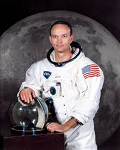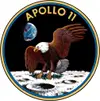Michael Collins is a former test pilot and astronaut most well-known for piloting the command module of Apollo 11, the mission during which Neil Armstrong and Buzz Aldrin walked on the Moon. 
Collins was born on Oct. 31, 1930, in Rome. His father, James, was in the U.S. Army; the family eventually settled in Washington, D.C., and young Michael went to school there. He graduated from St. Albans School and then completed his college studies at the U.S. Military Academy. He graduated from West Point in 1952 and became an Air Force pilot, training at several locations, including Nellis Air Force Base and George Air Force Base. In 1960, Collins joined the Experimental Test Pilot School at California's Edwards Air Force Base. Three years later, the National Aeronautics and Space Administration named him to be an astronaut. Collins specialized in extravehicular activity during the development stages of Project Gemini. Collins and John Young flew on Gemini 10 on July 18, 1966; among the tests and maneuvers that they completed were two spacewalks (both by Collins) and a rendezvous with an Agena docking vehicles. He was originally assigned to the crew of Apollo 8 but because of medical issues was reassigned to the role of Capsule Communicator (CAPCOM), handling all communications for the crew during flight. He was then named as Command Module pilot for Apollo 11. 
The historic spacecraft left Kennedy Space Center on July 16, 1969. They reached the Moon three days later and, after 30 orbits, went ahead with the historic task before them. On July 20, men first walked on the Moon. Collins stayed in Columbia, the Command Module, while Neil Armstrong and Buzz Aldrin descended to the Moon in Eagle, the Lunar Module. While the Eagle crew walked on the lunar surface and performed other tests and tasks, Collins kept close watch on his crewmates, performed maintenance tasks on the spacecraft he was in, and took photos of the Moon. The jubilant crew returned home without incident, splashing down in the Pacific Ocean on July 24. They spent 21 days in quarantine before moving to Houston. They were celebrated nationwide and worldwide, attending many state dinners and being the main celebrants in parades attended by hundreds of thousands of people. 
Collins had designed the Apollo 11 mission emblem, choosing the bald eagle as the symbol after a suggestion by fellow astronaut Jim Lovell and the olive branch after a suggestion from simulator instructor Tom Wilson. The crew together decided not to put their names on the emblem, as had previous crews, in order to emphasize that it had been a total team effort. Apollo 11 was Collins's last flight. President Richard Nixon named him the Assistant Secretary of State for Public Affairs, a capacity in which Collins served for two years. In 1971, he was named director of the National Air and Space Museum; he held that position for seven years and then was named undersecretary of the Smithsonian Institution. 
Once in the private sector, Collins joined LTV Aerospace, serving as vice president. He is an aerospace consultant, having formed his own company in 1985. A well-known creator of watercolor paintings, he is also an author; among his publications are Mission to Mars, a history of the U.S. space program; his autobiography, Carrying the Fire; and Flying to the Moon: an Astronaut's Story, a children's book. He had married Patricia Finnegan in 1957; they have three children. |
|
Social Studies for Kids
copyright 2002–2025
David White




